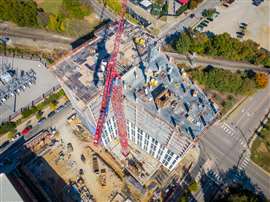US construction industry’s 3 biggest worries for 2024
09 January 2024
 Aerial view of high-rise construction in Raleigh, North Carolina (Image: Mathew via AdobeStock - stock.adobe.com)
Aerial view of high-rise construction in Raleigh, North Carolina (Image: Mathew via AdobeStock - stock.adobe.com)
Progress in the US construction industry this year could come with caveats, as contractors across the country prepare for a changing market that may bring both headwinds and tailwinds
The Associated General Contractors of America (AGC) recently released its annual outlook report and – while there is plenty to be positive about in the new year – the trade association conveyed that American contractors are concerned most by three looming problems: high interest rates/financing costs, a potential recession and labour shortages.
AGC executives discussed the findings earlier this month via webinar and analysed some of the data in AGC’s report – Construction Market in Transition: The 2024 Construction Hiring and Business Outlook.
The Economy
Ultimately, US contractors’ top three anxieties boil down to the economy.
According to AGC’s yearly survey of its members, 64% responded saying rising interest rates/financing costs were their biggest concern. An insufficient supply of workers or subcontractors came in second with 63%, and 62% of respondents were most alarmed by a possible economic slowdown/recession.
As for industry-specific worries, the top three fall in the same vein as the overview: 58% of contractors are worried about rising labour costs, 56% worker quality and 54% are troubled by material costs.
The good news is that unease could be letting up.
“Most of these concerns are cited less often in the 2024 survey than a year ago,” stated AGC’s outlook report.
Interest Rates/Financing Costs
Current interest rates in the US have set a new 20-year high (5.25% to 5.5%) just a few years after the rate was dropped to zero from early 2020 to
 Lynn Hansen, CEO of Crowder Constructors Inc. (Image: Crowders Construction Inc.)
Lynn Hansen, CEO of Crowder Constructors Inc. (Image: Crowders Construction Inc.)
early 2022.
The US Federal Reserve (Fed) aggressively raised interest rates – with stated hopes of creating a “soft landing” to prevent a recession in the wake of the pandemic – through 2022. Halfway through 2023, the Fed paused its regular rate increases and signalled plans to reduce rates in 2024.
This could be positive for the US economy and contractors, as lower rates may lead to more borrowing and, ultimately, more booked and finished projects in the construction industry.
The Fed, however, despite its gesturing, is not obligated to reduce interest rates in 2024. That fluidity could be driving lingering nervousness in the industry in anticipation of the Federal Reserve’s next meeting at the end of the month.
To combat the effects of present monetary policy and encourage construction, the US government has passed bipartisan legislation in recent years providing funding for infrastructure projects.
Lynn Hansen, CEO of Crowder Constructors in North Carolina, noted that some of the tools provided by the federal government (like Inflation Reduction Act [IRA] tax credits) have been useful to her company.
She noted, at least in her region, local municipalities and regional federal groups were making good use of government funding to tackle large road projects, municipal water/wastewater improvements and repairs to bridges, dams, and water intakes.
“IRA tax credits are making [industrial and alternative energy] projects more financially viable,” said Hansen, who added that public sector developments have been a key part of her company’s orders in 2023 and should continue into 2024. “Power companies and developers are planning numerous projects in our work areas in the alternative energy section.”
Recession?
“I’d just like a little stability,” added Hansen, addressing the looming threat of a potential slowdown or recession in America.
“Is there a slowdown? Are interest rates going up or down?” posited Hansen, noting these persistent questions make planning difficult. “Material costs are going up, but we think they are going down, [and] what about all the government regulation?”
Hansen referenced the US Davis-Bacon Act (1931), which is a US federal law that establishes the requirement for paying the local prevailing wages on public works projects for labourers and mechanics. It applies to “contractors and subcontractors performing on federally funded or assisted contracts in excess of $2,000 for the construction, alteration, or repair (including painting and decorating) of public buildings or public works.”
 Image: Joanne Dale via AdobeStock - stock.adobe.com
Image: Joanne Dale via AdobeStock - stock.adobe.com
While the intent of the law is to ensure fair wages for skilled labourers, it can, in theory, add to projects’ overall costs for prime contractors and subcontractors.
Many of Crowder’s projects – particularly some of the largest ones – Hansen said, are held to Davis-Bacon regulations. She noted those requirements apply to projects using federal funding, as well (not just projects on government-owned property).
There’s some concern in the industry that the barrage of red tape has prevented many firms and companies (most small or mid-sized) from even bidding.
“While the Biden Administration has been aggressive in announcing funding for many high-profile infrastructure and construction projects, it has demonstrated less enthusiasm for making legally required reforms to the federal review and permitting process,” stated AGC’s outlook report, referencing the Infrastructure Investment and Jobs Act (IIJA).
The report included data from its member survey showing only 9% of respondents had won a federal bid via IIJA and started work. The majority of respondents (33%) said the IIJA had no effect on their business in 2023.
“As a result, construction has yet to begin on many of the funded projects,” continued the release. “Adding to those delays are cumbersome… rules the administration has put in place that make it confusing and difficult for officials to ensure all products being used on a project are in compliance. These delays are likely one reason why contractor expectations for several public sector market segments are down this year compared to the start of 2023.”
The US Department of Labor announced updates to Davis-Bacon in August of 2023, which was the first major change to the act in roughly four decades. It came after the government passed the IRA in 2022 and the IIJA in 2021.
The changes and new rules, for some leaders in the industry, point to a sign that increased government regulation on the industry could be forthcoming.
“We expect it to continue over the next several years,” added Hansen.
She added that, even for firms that can handle the volume and bureaucracy, the new regulations regarding federal projects may cause delays and diminish profits.
“We’re bidding on projects we won’t finish for three to four years, and it’s hard to be profitable when you have all the ups and downs,” she said.
“My New Year’s wish is stability in the industry.”
Recruiting and retaining
With a lack of available skilled workers, firms have needed to poach talent from within the industry; a symptom of the shortage that is creating a meddlesome cycle.
 Photo: Adobe Stock
Photo: Adobe Stock
“Our good people are constantly being recruited – maybe for a little more money and maybe for a lot more money – [and] retaining our current employees is one of our top priorities as we start 2024,” said Hansen.
She added that, at Crowder, adjusting some culture elements and benefits has been helpful in retention.
“We’ve increased our wages, but we also took a look at our benefits,” Hansen said. “Time off is more important to younger employees.”
Attracting a new generation of construction-industry professionals, she added, remains a goal for Crowder. In addition to creating relationships with local schools, Hansen said Crowder recently launched an apprenticeship program.
She encouraged other companies wishing to do the same, though, to exercise patience (“it took us a year to have a registered apprenticeship program”).
A focus on new tech, Hansen believes, will help companies encourage the younger generation to pursue careers in construction. She said efficiency from mobile tech implementation at Crowder has provided gains in more than one way.
“Tech is one of the ways we can attract young talent, [and] mobile tech in the hands of our projects’ teams is good or all of us,” said Hansen.
The Outlook
While some might see “more of the same” from 2023 to 2024, the lack of radical novel disruptions in the last 12 months might paint a future more stable.
Of course, what the next 12 months bring could swing sentiment any numbers of ways, and AGC is preparing its members for a mixed bag with upside.
“If [the US Federal Government] can get out of its own way in moving infrastructure projects forward; if the Federal Reserve can successfully manage the ‘soft landing’ they have been pursuing; and if the industry can find a way to successfully recruit and retain more workers, 2024 should be a good year for most construction firms,” stated AGC.
STAY CONNECTED



Receive the information you need when you need it through our world-leading magazines, newsletters and daily briefings.
CONNECT WITH THE TEAM








